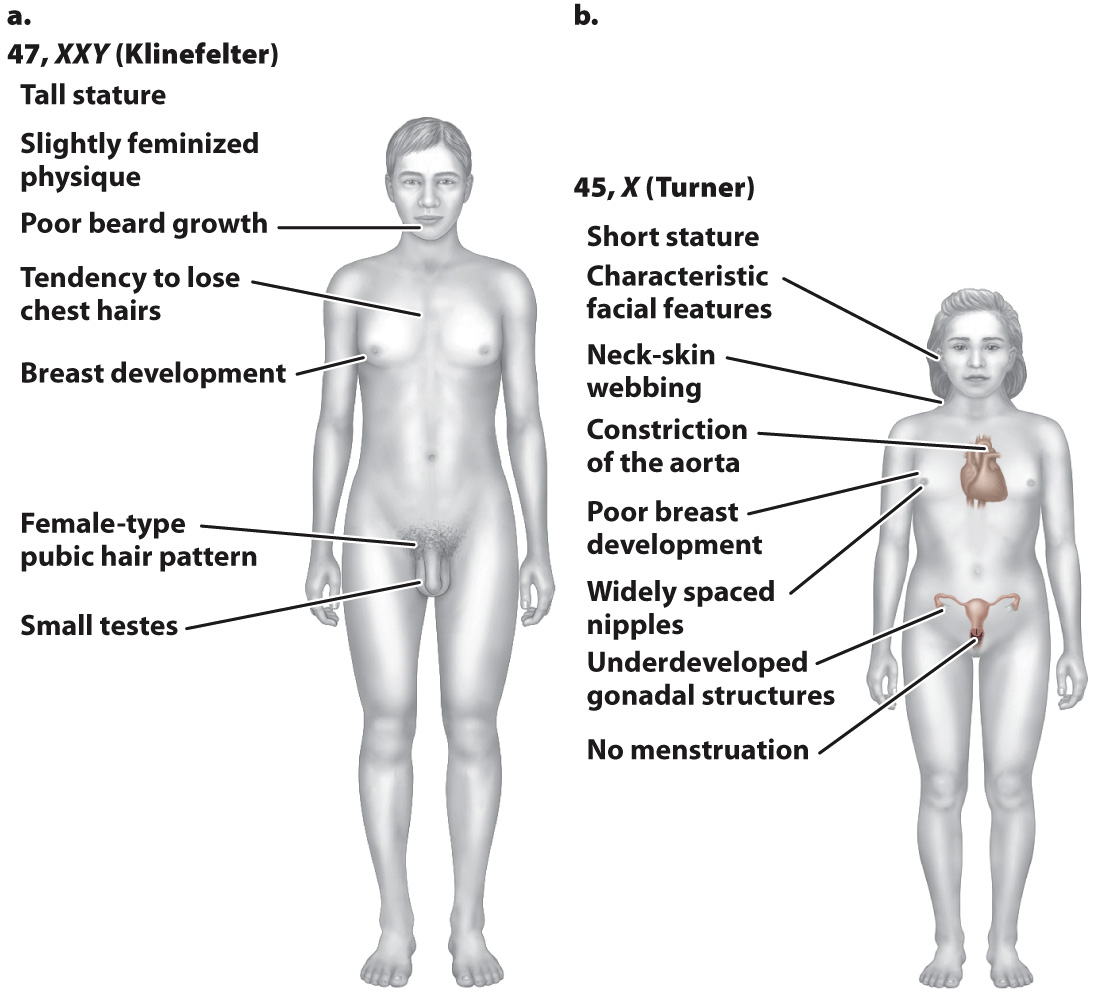Extra or missing sex chromosomes have fewer effects than extra autosomes.
Children born with an abnormal number of autosomes are rare, but extra or missing sex chromosomes (X or Y) are relatively common among live births. In most mammals, females have two X chromosomes (XX), and males have one X and one Y chromosome (XY). The presence of the Y chromosome, not the number of X chromosomes, leads to male development. The female karyotype 47, XXX (47 chromosomes, including three X chromosomes) and the male karyotype 47, XYY (47 chromosomes, including one X and two Y chromosomes) are found among healthy females and males. These persons are in the normal range of physical development and mental capability, and usually their extra sex chromosome remains undiscovered until their chromosomes are examined for some other reason.
321
The reason that 47, XYY males show no detectable phenotypic effects is the unusual nature of the Y chromosome. The Y contains only a few functional genes other than the gene that stimulates the embryo to take the male developmental pathway. The absence of detectable phenotypic effects in 47, XXX females has a completely different explanation that has to do with the manner in which the activity of genes in the X chromosome is regulated. In the cells of female mammals, all X chromosomes except one are inactivated and gene expression is largely repressed. (This process, called X-
Quick Check 6 A male baby is born with the sex-
Quick Check 6 Answer
Both Y chromosomes in the XYY baby must come from the father, so nondisjunction took place in the father. In normal meiosis, the first meiotic division separates the X chromosome from the Y chromosome, and the second meiotic division separates the sister chromatids of the X chromosome and the sister chromatids of the Y chromosome. For the Y chromosomes to remain together and be included in the same sperm, nondisjunction must take place in the second meiotic division (see Fig. 15.10c).
322
Two other sex chromosome abnormalities do have phenotypic effects, especially on sexual development (Fig. 15.13). The more common is 47, XXY (47 chromosomes, including two X chromosomes and one Y chromosome). Individuals with this karyotype are male because of the presence of the Y chromosome, but they have a distinctive group of symptoms known as Klinefelter syndrome (Fig. 15.13a). Characteristics of the syndrome are very small testes but normal penis and scrotum. Growth and physical development, for the most part, are normal, although affected individuals tend to be tall for their age. About half of the individuals have some degree of mental impairment. When a person with Klinefelter syndrome reaches puberty, the testes fail to enlarge, the voice remains high pitched, pubic and facial hair remain sparse, and there is some enlargement of the breasts. Affected males do not produce sperm and hence are sterile; up to 10% of men who seek aid at infertility clinics turn out to be XXY.

Much rarer than all the other sex chromosome abnormalities is 45, X (45 chromosomes, with just one X chromosome), the karyotype associated with characteristics known as Turner syndrome (Fig. 15.13b). Affected females are short and often have a distinctive webbing of the skin between the neck and shoulders. There is no sexual maturation. The external sex organs remain immature, the breasts fail to develop, and pubic hair fails to grow. Internally, the ovaries are small or absent, and menstruation does not occur. Although the mental abilities of affected females are very nearly normal, they have specific defects in spatial abilities and arithmetical skills.
Earlier, we saw that in XX females one X chromosome undergoes inactivation. Why, then, do individuals with just one X chromosome show any symptoms at all? The explanation is that some genes on the inactive X chromosome in XX females are not completely inactivated. Evidently, for normal development to take place, both copies of some genes that escape complete inactivation must be expressed.
A karyotype with 45, X is one of the rarest seen in live-